Keep it Evergreen
People talk about “evergreen content” and how it is content that can stay relevant for a long time. But this article is truly about Evergreen content about Evergreens because yard work doesn’t stop in the fall here in North Carolina. As a matter of fact, there are plenty of yard projects that can be done, including planting evergreen trees and shrubs
Because roots are active during fall, late winter, and early spring, good root activity is critical! The North Carolina Department of Agriculture says fall is the best time to transplant trees and shrubs. Since the fall season this year runs from September 22 through December 21, now is a perfect time to consider your tree and shrub needs.
Not sure what types of shrubs or evergreens to plant? Here are some ideas for you! Get those gardening tools out of your shed and get ready!
One of the thickest shrubs, EMERALD ARBORVITAE, is often used for privacy. It’s a hedge that grows one to two feet per year, lives up to 25 years, requires little to no maintenance or trimming, and can reach 15 feet if left unpruned.
The GREEN GIANT ARBORVITAE grows about three feet yearly, maxing out at 30 to 40 feet. It does well in NC and has a natural pyramidal to conical form with rich green foliage that slightly darkens or bronzes in the winter. Once established, it’s resistant to wind, heavy ice, and snow.
CHINDO VIBURNUM is a smaller shrub reaching 15 feet at full maturity. It produces lush, dense, dark green leaves as well as small flowers in the spring. In fall, it has red berries that ripen to black. It grows about 2 feet annually and is an excellent choice for a hedge or as a single specimen in a bed.
This next evergreen is popular for creating a natural fence in North Carolina. SPARTAN JUNIPER is more narrow than many other evergreens so you can plant them about four feet apart. It grows about four feet per year, reaching a total height of about 15 feet.
Many people think of pines when they hear the word “evergreen,” but this classification includes many other species. Junipers, hemlocks, redwoods and firs fit in this category. The same goes for many tropical plants, such as palm trees.
Evergreens provide shelter throughout the year. An assortment of animals can live in them thanks to excellent climbing or flying skills. They include grey squirrels, chipmunks, bald eagles, owls and chickadees. Some creatures take up residence in the holes created by woodpeckers.
Evergreens often benefit people who live nearby. During the winter, they can enhance comfort and cut heating expenses by protecting homes from brisk winds. Their thick foliage reduces cooling costs when it shields buildings from bright summer sunlight. They also block and absorb traffic noise throughout the year.
Douglas Fir, Blue Spruce, White Spruce and Eastern White Pine are a few evergreen trees that people use as Christmas Trees. In North Carolina, there are about 1,300 growers producing Fraser Fir Christmas trees on approximately 40,000 acres. As we head into the holiday season, you should be able to find your perfect Christmas tree right here at home!










